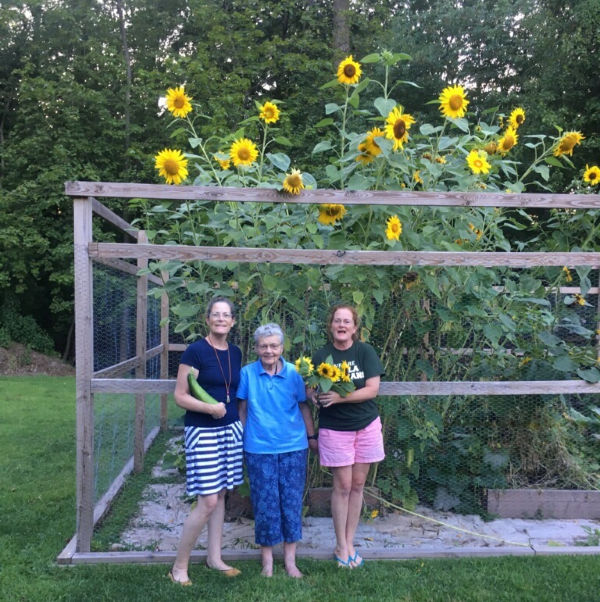
If you ever wanted to start growing vegetables, now is a great week to get started. We have been vegetable gardening in our backyard for years. Dad made the eight of us his reluctant weeding serfs. It was an unpleasant task, but this is one way we learned the basics. When our Mom joined two of us in Verona six years ago, we were elated that her new home had a very sunny and flat backyard to continue the gardening tradition. It’s not only a healthy way to grow your own food, but most importantly all eight of her children and 23 grandchildren love to get together and engage with Mom in some gardening hijinks.
Here are some basic guidelines. First, you need at least six hours of direct sunlight. Eight hours or more would be preferable. Second, a fence is necessary due to deer and groundhogs. It should be at least six feet tall and will have to also be dug down into the ground. Otherwise the groundhogs will start to burrow under the fence. You could pound stakes in and staple netting along the stakes. Rocks can be used as a bottom anchor, but you will have to be vigilant about the groundhogs. Another option is to use untreated landscaping timber along the edge. Don’t forget a convenient access or door. If you are lucky, you may come across an old screen door on bulk day. Take it and attach loosely with zip ties so it swings. Remember to always keep it closed securely when you leave the garden. A final addition would be pinwheels. They act as a deterrent for birds and squirrels, as the metal reflections and clicking sounds will scare them off. Zip tie the pinwheels to the stakes.
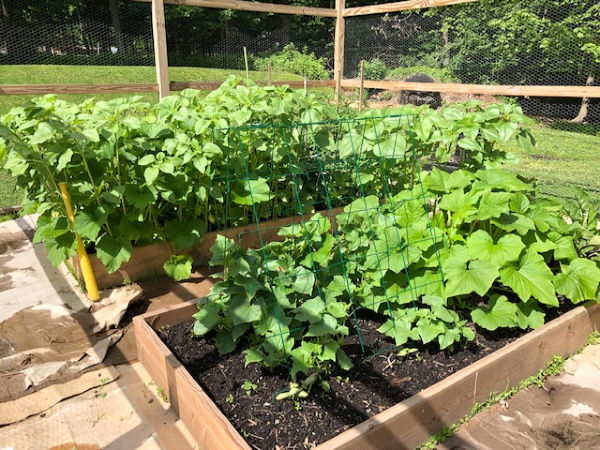
Raised beds make it easier to control weeds. We made ours out of untreated pine 2 X 10s. Cedar is an option, but it’s very expensive. Our 4 X 10 pine beds should last at least 5 seasons. Don’t make them wider than 4 ft. as you need to be able to reach across to weed. To fill the beds, we ordered soil from a local nursery. There are convenient online calculators so you can determine how much soil you need. I also compost at my home and amend our soil with the resulting rich mixture.
In our plan, we left three feet around each bed. When weeding, we sit on a small stool and rotate around the beds. Between the beds, we put down cardboard for weed control. Obviously, you can locally source your cardboard. We hit the cardboard lottery with a find of 10 X 3 sheets at the Episcopal Church of the Holy Spirit one day. They fit perfectly between the beds. The cardboard will decay over the year and you will have to put down new cardboard every spring. You can also use a weed whacker to get the edges. Just be careful as that activity can spread unwanted weed seeds. Black plastic isn’t a good option for us, as it will kill beneficial microorganisms in the soil.
Watering is a free workout. I prefer not to use a sprinkler, as it will water weeds. We thought about installing a system, but we decided it wasn’t worth the effort. The hose can reach two of the beds and we use a bucket for the rest. Watering is an experiment. Don’t splash the leaves, as that can encourage mold. Don’t over or underwater. I think of my Dad saying, “Give them a nice long drink.” This year we aspire to install a rain barrel.
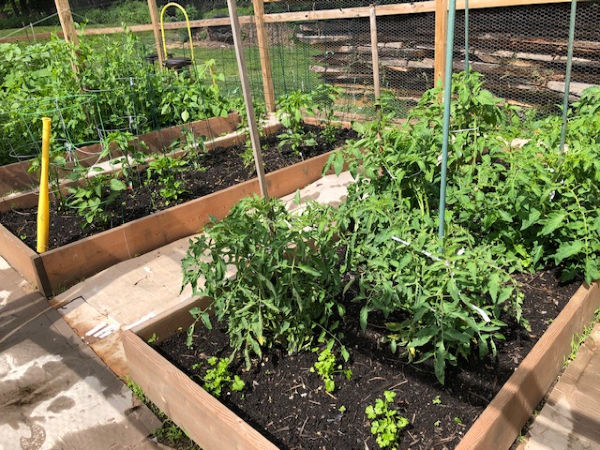
Each plant has certain space requirements. If you overcrowd, the vegetables won’t produce as proficiently. Tomatoes need to be held up with either a cage or stakes. Either system must be securely anchored. We have tried both systems, and every year some of them blow over. This year we plan on anchoring the cages with bent hangars. Old cotton shirts can be ripped and the long strips can be used to tie the vegetables. We plant parsley and basil around the tomatoes and peppers. Most of the parsley becomes a home to the swallowtail butterflies. They are a joy to watch as they complete their life cycle.
Some of the vegetables we start from seed. This week, we will be planting lettuces, peas, spinach, leeks, carrots, beans, and beets. I also save sunflower heads every year. Sunflowers are planted along the perimeter. We cut them off in the late fall and dry the heads in the garage where mice and chipmunks can’t reach them. Some we hang in the yard for winter birds and others we save for next year’s crop. When you buy a cantaloupe, save the seeds. They can be planted in your garden. Put five or six seeds in a hole about one inch deep. I use my finger for this. Add some type of netting or pyramid for them. The squash won’t be that big but it’s fun to watch and they are so pretty. The end of April/early May is when we put in our tomatoes, peppers, cucumbers, and squash. We buy them already started from a local nursery. Again, you can start from seed as our Dad liked to, but for that you need adequate space and indoor light.
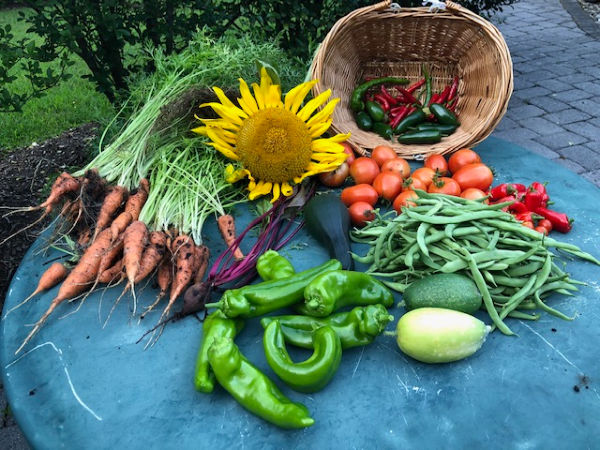
In the fall, we pull everything out and put it in the corner of the yard. We cover it with leaves. It turns back into soil. Or you could put it all in a leaf bag. In the Spring, turn the soil with a pitchfork. We don’t use any chemicals or fertilizers.
Every year, we try something different. It’s an ongoing experiment. At the peak, we have so much produce that we have to freeze quite a bit. We reuse the little paper bags from the pharmacy to make fresh vegetable gift bags for friends and neighbors. Does this make your mouth water? If it does, get outside and get busy digging!
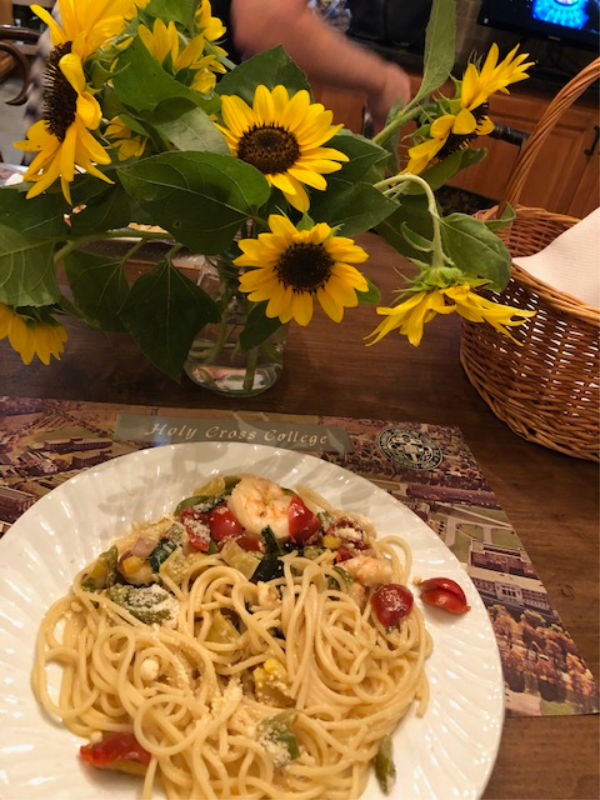


Hi Sarah! This is wonderful!!! We are going to follow ion your footsteps (and we didn’t even know it until I saw this article!!!). Good tips!!! We’ll follow every one of them!
Thank you so much for this wonderful article chock full of practical tips! We just installed raised beds last year and can’t wait to get started. Can you please show a photo of how you used hangers to secure your tomato cages?